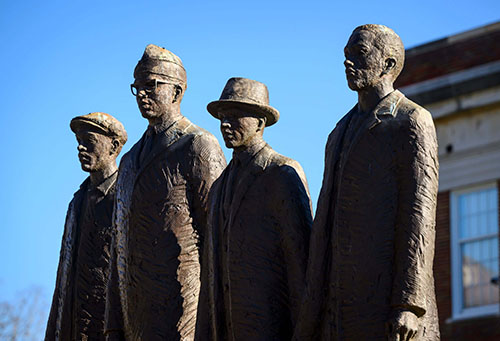
N.C. A&T Joins NCShare Partnership, Enhances Computing and Data Modeling Capacity
04/23/2025 in Research, College of Engineering
By Jackie Torok / 01/03/2025 Alumni
EAST GREENSBORO, N.C. (Jan. 3, 2025) – The National Park Service has designated the F.W. Woolworth Co. Building, where four teenage North Carolina Agricultural and Technical State University freshmen staged a sit-in that buoyed the Civil Rights Movement, a National Historic Landmark.

On Feb. 1, 1960, Jibreel Khazan (formerly Ezell Blair Jr.), Joseph McNeil, the late Franklin McCain Sr. and the late David Richmond seated themselves at Woolworth’s whites-only lunch counter in downtown Greensboro. Students from Bennett College, Dudley High School and the University of North Carolina-Greensboro joined their peaceful protest, which others replicated across the country to stand up against racial inequality, until Woolworth’s guaranteed equal access to all of its lunch counters.
The sit-ins provided strong momentum for the inclusion of public accommodations as a protected category in the Civil Rights Act of 1964. Public accommodations are businesses and venues open to the public, such as movie theaters, sports arenas and, yes, lunch counters.
“Their sit-in inspired thousands of people to demand equal treatment in shops, restaurants and other public places,” the National Park Service noted. “It also opened new opportunities for Black youth to take on leadership roles in the Civil Rights Movement.”
According to the National Historic Landmark executive summary on the site, “The lunch counter sit-ins by the four students reinvigorated the modern civil rights movement by shifting strategy toward nonviolent direct-action protests such as sit-ins as a way to supplement voter registration drives and boycotts.
“(They) introduced a new youthful leadership in the civil rights movement that led to the formation of the Student Non-Violent Coordinating Committee, which challenged older leaders from the NAACP and the Southern Christian Leadership Conference. Over the next five years, Black youth often set the course of civil rights protest.
“The defiance of the A&T Four “characterized and inspired the aggressive insistence by young people of the 1960s that the United States fulfill its ideals of freedom and equality, inspiring protest movements by other oppressed groups such as women and Native Americans and sparking the student-led Free Speech movement and protests against the Vietnam War.”
Today, the former Woolworth’s – where a portion of the lunch counter has been preserved – has been restored to house the International Civil Rights Center & Museum, established and operated by Sit-In Movement Inc. since 2010.
The citizens who organized Sit-In Movement Inc. to save the building from demolition began inquiring about National Historic Landmark designation after Woolworth closed the lunch counter in 1993, but the effort stalled.
The sit-ins provided strong momentum for the inclusion of public accommodations as a protected category in the Civil Rights Act of 1964. Public accommodations are businesses and venues open to the public, such as movie theaters, sports arenas and, yes, lunch counters.
“Their sit-in inspired thousands of people to demand equal treatment in shops, restaurants and other public places,” the National Park Service noted. “It also opened new opportunities for Black youth to take on leadership roles in the Civil Rights Movement.”
According to the National Historic Landmark executive summary on the site, “The lunch counter sit-ins by the four students reinvigorated the modern civil rights movement by shifting strategy toward nonviolent direct-action protests such as sit-ins as a way to supplement voter registration drives and boycotts.
“(They) introduced a new youthful leadership in the civil rights movement that led to the formation of the Student Non-Violent Coordinating Committee, which challenged older leaders from the NAACP and the Southern Christian Leadership Conference. Over the next five years, Black youth often set the course of civil rights protest.
“The defiance of the A&T Four “characterized and inspired the aggressive insistence by young people of the 1960s that the United States fulfill its ideals of freedom and equality, inspiring protest movements by other oppressed groups such as women and Native Americans and sparking the student-led Free Speech movement and protests against the Vietnam War.”
Today, the former Woolworth’s – where a portion of the lunch counter has been preserved – has been restored to house the International Civil Rights Center & Museum, established and operated by Sit-In Movement Inc. since 2010.
The citizens who organized Sit-In Movement Inc. to save the building from demolition began inquiring about National Historic Landmark designation after Woolworth's closed the lunch counter in 1993, but the effort stalled.
In 2017, scholars and preservationists assisting the Georgia State University (GSU) World Heritage Initiative identified the Woolworth’s as a potential component of UNESCO World Heritage serial nomination for U.S. Civil Rights Movement Sites. Since World Heritage program requirements specify that a site must have achieved the highest federal designation possible, the Sit-In Movement Inc., in consultation with the GSU World Heritage Initiative, resumed the effort to seek National Historic Landmark designation.
The Woolworth’s was added to the National Register of Historic places in 1984 as part of the Downtown Greensboro Historic District.
N.C. A&T will commemorate the 65th anniversary of the A&T Four’s courageous act with a celebration, “Perseverance: The Power of an Ageless Evolution,” on Friday, Jan. 31. The event will begin at 7 a.m. with breakfast, guest speakers and a program – including the awarding of the N.C. A&T Human Rights Medal that honors the A&T Four – in the Alumni-Foundation Event Center, followed by a wreath laying at the February One monument and high school engagement program at 10:30 a.m. in Harrison Auditorium.
Media Contact Information: jtorok@ncat.edu